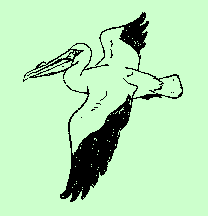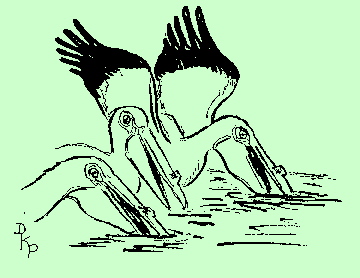|
The White Pelican
"Aerial Acrobats with Huge Bills"

 Pelicans are large aquatic, fish-eating birds with all four toes webbed, and
have been known since Pleistocene times. They are excellent swimmers. Two of the
eight species in the world are in the Americas -- the white and the brown. Utah
is fortunate to have the White Pelican (Pelecanus Erythrorhynchos)
breeding on Gunnison Island in Great Salt Lake, the second largest colony in
numbers of young pelicans produced in North America (Deseret News, 9-19-72),
and the only colony left in Utah. The majority of these feed on Bear River
Migratory Bird Refuge, Brigham City, Utah.
Pelicans are large aquatic, fish-eating birds with all four toes webbed, and
have been known since Pleistocene times. They are excellent swimmers. Two of the
eight species in the world are in the Americas -- the white and the brown. Utah
is fortunate to have the White Pelican (Pelecanus Erythrorhynchos)
breeding on Gunnison Island in Great Salt Lake, the second largest colony in
numbers of young pelicans produced in North America (Deseret News, 9-19-72),
and the only colony left in Utah. The majority of these feed on Bear River
Migratory Bird Refuge, Brigham City, Utah.


 The adult White Pelican is a large (55" to 65") heavy bodied (17 to 20 lb.)
bird with the black area of the wings including all of the primaries and half
of the secondaries. The wing spread ranges from 8 1/2 to 10 feet. The enormous
bill, even for such a large bird, is yellow to orange in color, the lower
mandible bearing a pouch of elastic, naked skin. This lower portion of the bill
is submerged to scoop up the fish. Several birds may cooperate to drive the
fish into the shallows for easier capture. On such raids a bird may eat a third
of its own weight before resting and digesting the catch. Unlike brown pelicans,
they never dive for fish.
The adult White Pelican is a large (55" to 65") heavy bodied (17 to 20 lb.)
bird with the black area of the wings including all of the primaries and half
of the secondaries. The wing spread ranges from 8 1/2 to 10 feet. The enormous
bill, even for such a large bird, is yellow to orange in color, the lower
mandible bearing a pouch of elastic, naked skin. This lower portion of the bill
is submerged to scoop up the fish. Several birds may cooperate to drive the
fish into the shallows for easier capture. On such raids a bird may eat a third
of its own weight before resting and digesting the catch. Unlike brown pelicans,
they never dive for fish.

 The plumage changes with the seasons, but is mainly white in June. A thin
yellowish crest is at the back of the head, and yellowish feathers are on the
breast and lesser wing coverts. During the breeding season there is a horny
prominence on the upper bill. Though they are clumsy, and waddle on land, the
white pelicans, as Dr. J. H. Paul writes, "... ride on the water like squadrons
of white ships, or soar in splendid flight like a fleet of air-ships of the
newer models -- steady, graceful, impressive."
The plumage changes with the seasons, but is mainly white in June. A thin
yellowish crest is at the back of the head, and yellowish feathers are on the
breast and lesser wing coverts. During the breeding season there is a horny
prominence on the upper bill. Though they are clumsy, and waddle on land, the
white pelicans, as Dr. J. H. Paul writes, "... ride on the water like squadrons
of white ships, or soar in splendid flight like a fleet of air-ships of the
newer models -- steady, graceful, impressive."


 Dr. Paul visited Bird Island in Great Salt Lake many years ago, and found the
nests were located in depressions in the sand or on flat rocks which covered
the rugged surface of the island. They were lined with a thin layer of sticks
and leaves, and contained from one to four dull white eggs, stained. Formerly
a marvelous rookery, it is now abandoned. Dr. Paul continues his observations
there, "Long V-shaped lines of pelicans arose and floated majestically on
steadily beating or motionless wings. The water was covered with birds, swimming
from their rocky coverts ... in places the sky was obscured by their numbers.
Young pelicans, in droves resembling sheep, floundered clumsily over the rocks,
trying to reach the water."
Dr. Paul visited Bird Island in Great Salt Lake many years ago, and found the
nests were located in depressions in the sand or on flat rocks which covered
the rugged surface of the island. They were lined with a thin layer of sticks
and leaves, and contained from one to four dull white eggs, stained. Formerly
a marvelous rookery, it is now abandoned. Dr. Paul continues his observations
there, "Long V-shaped lines of pelicans arose and floated majestically on
steadily beating or motionless wings. The water was covered with birds, swimming
from their rocky coverts ... in places the sky was obscured by their numbers.
Young pelicans, in droves resembling sheep, floundered clumsily over the rocks,
trying to reach the water."

 Thirty years ago there was a colony of white pelicans on Rock Island in Utah
Lake, but excursions by boat each week to see them, and human disturbances soon
caused the birds to abandon the site. Before the Federal Refuge was established,
the parent birds flew on their strong wings to the mainland from Gunnison Island
to feed at the mouths of the Weber and Bear Rivers; now they fish in great
numbers in the Bear River Migratory Bird Refuge.
Thirty years ago there was a colony of white pelicans on Rock Island in Utah
Lake, but excursions by boat each week to see them, and human disturbances soon
caused the birds to abandon the site. Before the Federal Refuge was established,
the parent birds flew on their strong wings to the mainland from Gunnison Island
to feed at the mouths of the Weber and Bear Rivers; now they fish in great
numbers in the Bear River Migratory Bird Refuge.

 Robert C. Murphy writes of his visit in the spring of 1915 to another famous
white pelican area, "Lower Klamath Lake, along the border of California and
Oregon, was full of floating mats of cattails and rushes through which green
shoots were sprouting. These rafts of vegetation held hundreds of nesting White
Pelicans. The birds had raked up mounds of debris, and laid their eggs on top.
Some had hatched and the featherless, flesh colored, rubbery chicks seemed
unreal -- they had such short bills. The baby pelicans feed on regurgitated
"soup" in their parents' pouches -- this is the only food pelicans hold in these
great scoops, for they swallow their catch as soon as they have drained off the
water. Soon the young begin thrusting their fast-lengthening bills far into the
adult gullets for fish that are less digested. By the end of two weeks they have
sprouted white down that made them look like lambs. They bleated too, though the
adults were silent as brown pelicans. A few years later, the Klamath marshes
were drained to provide land for homesteaders. The birds vanished, and the
exposed bottomlands proved too poor to grow crops. In 1935 the U.S. Department
of Interior restored twenty thousand acres of the marsh, and happily the White
Pelicans returned."
Robert C. Murphy writes of his visit in the spring of 1915 to another famous
white pelican area, "Lower Klamath Lake, along the border of California and
Oregon, was full of floating mats of cattails and rushes through which green
shoots were sprouting. These rafts of vegetation held hundreds of nesting White
Pelicans. The birds had raked up mounds of debris, and laid their eggs on top.
Some had hatched and the featherless, flesh colored, rubbery chicks seemed
unreal -- they had such short bills. The baby pelicans feed on regurgitated
"soup" in their parents' pouches -- this is the only food pelicans hold in these
great scoops, for they swallow their catch as soon as they have drained off the
water. Soon the young begin thrusting their fast-lengthening bills far into the
adult gullets for fish that are less digested. By the end of two weeks they have
sprouted white down that made them look like lambs. They bleated too, though the
adults were silent as brown pelicans. A few years later, the Klamath marshes
were drained to provide land for homesteaders. The birds vanished, and the
exposed bottomlands proved too poor to grow crops. In 1935 the U.S. Department
of Interior restored twenty thousand acres of the marsh, and happily the White
Pelicans returned."

 -- by Marie L. Atkinson -- by Marie L. Atkinson

REFERENCES:
Out of Doors In the West
Dr. J. H. Paul

National Geographic -- Pelicans
Robert Cushman Murphy

Audubon Illustrated Handbook of American Birds
Edgar M. Reilly, Jr.
|
|


